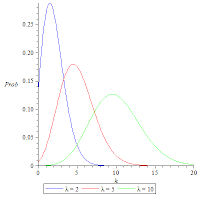 The
Poisson distribution began life with unusual applications. It is a statistical
function that is used to determine how many events of low probability will occur
in a given time frame. It is useful because only the average number
of occurrences needs to be known. From this, one can calculate
the probability that the event will happen zero times in a given time interval,
or fifty times. λ is the expected number of occurrences in a
time frame, and the probability that there will be exactly
k occurrences of the phenomenon in a given time frame is given by the
function on the right.
The
Poisson distribution began life with unusual applications. It is a statistical
function that is used to determine how many events of low probability will occur
in a given time frame. It is useful because only the average number
of occurrences needs to be known. From this, one can calculate
the probability that the event will happen zero times in a given time interval,
or fifty times. λ is the expected number of occurrences in a
time frame, and the probability that there will be exactly
k occurrences of the phenomenon in a given time frame is given by the
function on the right.
 |
| Poisson Distribution for various values of λ |
His distribution was brought to greater prominence by Ladislaus Josephovich Bortkiewicz (1868-1931), a Polish statistician. In 1898 he published a book entitled, in English translation, The Law of Small Numbers, in which he showed that the Poisson distribution held for events even when the probabilities varied. His examples were the number of men killed by horse kicks in the Prussian army over a 20 year period and the number of children who committed suicide in Prussia. His work brought the Poisson distribution to a wider audience, and it is often called the Law of Small Numbers today. As you can see, the Poisson distribution can be applied to many different situations, and some modern applications include the number of calls that a cell tower receives and the number of beds that an emergency room needs to have available.
[1] For a more detailed discussion of Poisson's work, see "A Study of Poisson's Models for Jury Verdicts in Criminal and Civil Trials" by Alan E. Gelfand and Herbert Solomon in the
Journal of the American Statistical Association , Vol. 68, No. 342 (Jun., 1973), pp. 271-278.
Well Elaborated Content with proper explanation about poisson distribution. It will be easy to understand even more if Binomial Vs Poisson Distribution is analyzed and compared carefully.
ReplyDelete